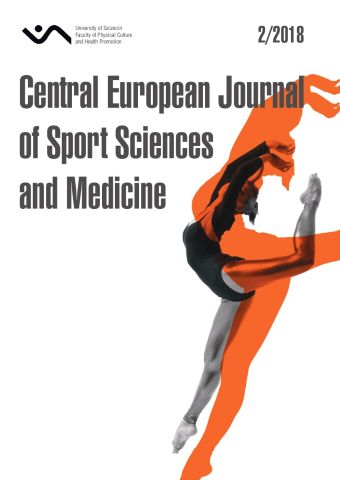
ISSN: 2300-9705
eISSN: 2353-2807
OAI
DOI: 10.18276/cej.2018.2-09




Lista wydań /
Vol. 22, No. 2/2018
School Environment versus Home Environment - Comparison of Selected Parameters of Children Physical Activity
| Autorzy: |
Jarosław
Herbert

University of Rzeszów, Faculty of Physical Education |
| Słowa kluczowe: | physical activity accelerometer school kindergarten WGT3X |
| Data publikacji całości: | 2018-06-31 |
| Liczba stron: | 9 (79-87) |
Abstrakt
In recent years research have shown a significant decrease in physical activity (PA) among young population. Increasingly carried out diagnosis of physical activity at different stages of our lives, with particular regard to children and adolescents indicates that with age, level of physical activity, especially in leisure time is reduced. The purpose of the research is to compare the selected parameters of physical activity during one day among students aged 6-8 years old. The study was conducted with use of the accelerometer ActiGraph WGT3X on group of 54 children (30 - school and 24 - kindergarten). Analysis shows that for such parameters as MET's, Vigorous, Total MVPA and Steps Counts one observed difference between the stay at school and sometimes school has statistical significance (p < 0,05).
On the basis of the studies carried out it is shown that the school environment helps to increase physical activity among children in school and the fact is that these children are more active.
Pobierz plik
Plik artykułu
Bibliografia
| 1. | Bower, J.K., Hales, D.P., Tate, D.F., Rubin, D.A., Benjamin, S.E., Ward, S.E. (2008). The Childcare Environment and Children’s Physical Activity. Am J Prev Med, 34, 23–29. |
| 2. | Brettschneider, W.D., Naul, R. (2004). Final report on „Study on young people’s lifestyles and sedentariness and role of sport in the context of education and as a means of restoring the balance. Paderborn. |
| 3. | Brown, W.H., Pfeiffer, K.A., McIver, K.L., Dowda, M., Addy, C.L., Russell, R.P. (2009). Social and environmental factors associated with preschoolers’ non sedentary physical activity. Child Dev., 80, 45–58. |
| 4. | Carson, V., Cliff, D.P., Janssen, X., Okely, A.D. (2013). Longitudinal levels and bouts of sedentary time among adolescent girls. BMC Pediatrics, 13, 173. |
| 5. | Corder, K., Ogilvie, D., Van Sluijs, E.M. (2009). Invited commentary: physical activity over the life course – whose behavior changes, when, and why?” Am J Epid, 170, 1078–1081. |
| 6. | Cox, M., Schofield, G., Greasley, N., Kolt, GS. (2006). Pedometer steps in primary school-aged children: a comparison of school-based and out-of-school activity. J Sci Med Sport, 9, 91–97. |
| 7. | Dumith, S.C., Gigante, D.P., Domingues, M.R., Kohl, H.W. (2011). 3rd. Physical activity change during adolescence: a systematic review and a pooled analysis. Int J Epidemiol, 40, 685–698. |
| 8. | Gabel, L.A., Proudfoot, N.A., Obeid, J., MacDonald, M.J., Bray, S.R., Cairney, J., Timmons B.W. (2012). Step Count Targets Corresponding to New Physical Activity Guidelines for the Early Years. Medicine and Science in Sports and Exercise, 45, 314–318. |
| 9. | GT3X+ and WGT3X+ Device Manual. (2014). The ActiGraph, Pensacola. |
| 10. | Guinhouya, B.C., Samouda, H., Zitouni, D., Vilhelm, C., Hubert, H. (2011). Evidence of the influence of physical activity on the metabolic syndrome and/or on insulin resistance in pediatric populations: a systematic review. Int J Pediatr Obes, 6, 361–388. |
| 11. | Herbert, J., Czarny, W. (2013) Accelerometer wgt3x addition to studies of physical activity. Scientific Review of Physical Culture, 3 (3), 167–172. |
| 12. | Hills, A.P., Mokhtar, N., Byrne, N.M. (2014). Assessment of physical activity and energy expenditure: an overview of objective measures. Frontiers in Nutrition, 1, 5. DOI: 10.3389/fnut.2014.00005. |
| 13. | Janssen, I., Leblanc, A.G. (2010). Systematic review of the health benefits of physical activity and fitness in school-aged children and youth. Int J Behav Nutr Phys Act, 7, 40. |
| 14. | Pagels, P., Boldemann, C., Raustorp, A. (2011). Comparison of pedometer and accelerometer measures of physical activity during preschool time on 3-to 5-year-old children. Acta Pediatric, 100, 116–120. |
| 15. | Russell, R., Stevens, J., Pratt, C., Sallis, J., Schmitz, K., Webber, S., …, Young, D. (2006). Objectively Measured Physical Activity in Sixth-Grade Girls. Arch Pediatr Adolesc Med, 160 (12), 1262–1268. |
| 16. | Steele, R.M., Van Sluijs, E.M., Sharp, S.J., Landsbaugh, J.R., Ekelund, U., Griffin, S.J. (2010). An investigation of patterns of children’s sedentary and vigorous physical activity throughout the week. Int J Behav Nutr Phys, 7, 88. |
| 17. | Tanaka, C., Tanaka, S. (2009). Daily physical activity in Japanese preschool children evaluated by triaxial accelerometry: the relationship between period of engagement in moderate-to-vigorous physical activity and daily step counts. Journal of physiological anthropology, 28, 283–288. |
| 18. | Telford, R.M., Telford, R.D., Cunningham R.B., Cochrane T., Davey, R., Waddington, G. (2013). Longitudinal patterns of physical activity in children aged 8 to 12 years: the LOOK study. International Journal of Behavioral Nutrition and Physical Activity, 10, 81. |
| 19. | Thompson, A.M., McHugh, T.L., Blanchard, CH.M., Campagna, F.D., Durant, M.A., Rehman, L.A., Murphy, R.L., Wadsworth, L.A. (2009). Physical activity of children and youth in Nova Scotia from 2001/02 and 2005/06. Preventive Medicine, 49 (5), 407–409. |
| 20. | Tudor-Locke, C., Lee, S.M., Morgan, C.F., Beighle, A., Pangrazi, R.P. (2006). Children’s pedometer-determined physical activity during the segmented school day. Med Sci Sports Exerc, 38, 1732–1738. |
| 21. | Tudor-Locke, C., Craig, C.L., Beets, M.W., Raustrop, A., Rowe, D.A., Spence, J.C., … Balir, S.N. (2011). How Many Steps/Day are Enough? for Children and Adolescents. International Journal of Behavioral Nutrition and Physical Activity, 8, 78. |
| 22. | Vale, S., Trost, S.G., Duncan, M.J., Mota, J. (2015). Step based physical activity guidelines for preschool-aged children. Preventive Medicine, 70, 78–82. |